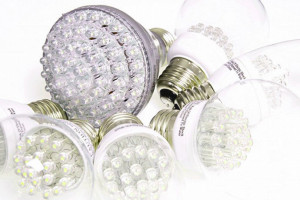Why LEDs?
 The most energy efficient, the cleanest and most eco-friendly light bulbs today are LEDs (light emitting diodes). You certainly hear and read a lot about the advantages and benefits of the energy efficient LEDs vs. traditional lighting. And, when compared to other energy-saving illumination methods available today, LED lighting has many advantages—saving power, saving money, saving the planet.
The most energy efficient, the cleanest and most eco-friendly light bulbs today are LEDs (light emitting diodes). You certainly hear and read a lot about the advantages and benefits of the energy efficient LEDs vs. traditional lighting. And, when compared to other energy-saving illumination methods available today, LED lighting has many advantages—saving power, saving money, saving the planet.
Top 10 Benefits of LED Lighting
1. Long Life
Long lifetime stands out as the number one benefit of LED lights. LED bulbs and diodes have an outstanding operational lifetime expectation of up to 100.000 hours. This is 11 years of continuous operation, or 22 years of 50% operation. If you leave on the LED fixture for 8 hours per day it would take around 20 years before you’d have to replace the LED bulb.
LED’s are different to standard lighting: They don’t really burn out and stop working like a standard light. They just emit lower output levels over a very long period of time and become less bright.
2. Energy Efficiency
Today’s most efficient way of illumination and lighting, LEDs provide an estimated energy efficiency of 80%-90% when compared to traditional lighting and conventional light bulbs. This means that about 80% of the electrical energy is converted to light, while conventional light bulbs lose 20% of their energy which is converted into other forms of energy such as heat.
In fact, traditional incandescent light bulbs operate at 20% energy efficiency, and up to 80% of the electricity is lost as heat. If you use traditional lighting and have an electricity bill of $100, then $80 of that money has been used to heat the room, not to light it! Using LED illumination with 80% efficiency, the electricity costs would be around $20 and you’d have saved around $80.
Because the long life span of LED lights, you also save when it comes to maintenance and replacement costs.
3. Ecologically Friendly
LED lights are free of toxic chemicals. Most conventional fluorescent lighting bulbs contain a multitude of materials like mercury that are dangerous for the environment.
LED lights contain no toxic materials and are 100% recyclable, and will help you to reduce your carbon footprint by up to a third. The long operational life span mentioned above means also that one LED light bulb can save material and production of 25 incandescent light bulbs. A big step towards a greener future!
4. Durable Quality
LEDs are extremely durable and built with sturdy components that are highly rugged and can withstand even the roughest conditions. Because LED lights are resistant to shock, vibrations and external impacts, they make great outdoor lighting systems for rough conditions and exposure to weather.
5. Zero UV Emissions
LED illumination produces little infrared light and close to no UV emissions. Because of this, LED lighting is healthier and highly suitable for goods and materials that are sensitive to heat (due to low radiated heat emission) and illumination of UV sensitive objects or materials such an in museums, art galleries, archeological sites etc.
6. Design Flexibility
LEDs can be combined in any shape to produce highly efficient illumination. Individual LEDs can be dimmed, resulting in a dynamic control of light, color and distribution. Well-designed LED illumination systems can achieve fantastic lighting effects, not only for the eye but also for the mood and the mind.
7. Operational In Extremely Cold Or Hot Temperatures
LEDs are ideal for operation under cold and low outdoor temperature settings. For fluorescent lamps, low temperatures may affect operation and present a challenge, but LED illumination operates well in cold setting and is great for outdoor winter lighting
8. Light Dispersal
LED is designed to focus its light and can be directed to a specific location without the use of an external reflector, achieving higher application efficiency than conventional lighting. Well-designed LED illumination systems are able to deliver light more efficiently to a desired location.
9. Instant Lighting & Frequent Switching
LED lights brighten up immediately when powered on, which has great advantages for home safety. Also, LED lights can switch off and on frequently without affecting the LED’s lifetime or light emission. In contrast, traditional lighting may take several seconds to reach full brightness, and frequent on/off switching does drastically reduce operational life expectancy.
10. Low-Voltage
A low-voltage power supply is sufficient for LED illumination. This makes it easy to use LED lighting in outdoor settings, and by connecting an external solar-energy source there are even bigger advantages when it comes to using LED technology.
